What Is TSN?
Time-Sensitive Networking (TSN) provides a protocol suite developed by IEEE 802.1 to enable deterministic minimum delay on the non-deterministic Ethernet. TSN provides a set of universal time-sensitive mechanisms for the data link layer of the Ethernet protocols. It also guarantees real-time, deterministic, and reliable data transmission on the standard Ethernet, thereby improving data transmission efficiency. In addition, TSN can transmit both time-sensitive and non-time-sensitive data on the same network.
What Are the Important Protocols Included in TSN?
Traditional Ethernet uses the carrier sense multiple access with collision detection (CSMA/CD) mechanism to avoid the collision that occurs when two or more stations send data at the same time. When collisions occur, there can be a long delay in packet transmission, causing unpredictable communication times. In the past, data that required high real-time performance was transmitted through real-time Ethernet. Data with and without real-time requirements typically needs to be transmitted separately through two networks. All controllers have two network ports, one for real-time Ethernet and the other for standard Ethernet. As a result, it is difficult to integrate information technology (IT) and operational technology (OT). TSN not only ensures real-time and deterministic data transmission, but also enables both time-sensitive and non-time-sensitive data to be transmitted on the same network.
TSN provides a set of protocol standards (TSN protocol suite) to implement real-time and deterministic data transmission on the same network, ensuring the smooth transmission of real-time information in different standard Ethernet scenarios. The TSN protocol suite is highly flexible, so users can select protocols based on their application requirements. The TSN protocol suite consists of sub-protocols in four categories, namely clock synchronization, data scheduling and traffic shaping, reliability, and resource management.
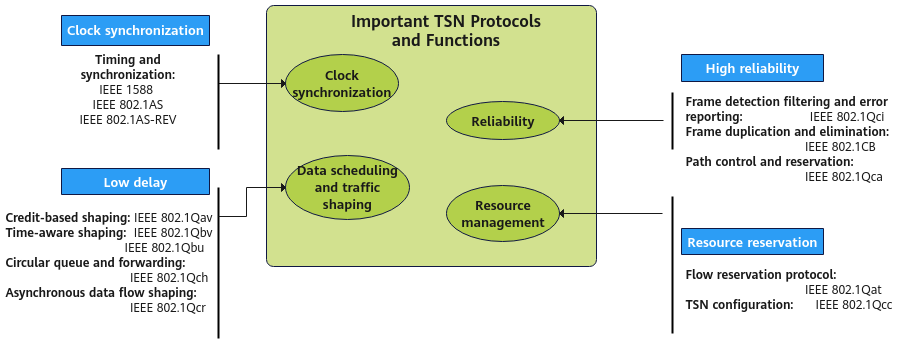
Important TSN protocols and functions
Clock Synchronization
Compared with the standard Ethernet defined in IEEE 802.3, clocks play an important role in a TSN network. For real-time communication, the end-to-end transmission delay is difficult to negotiate. Therefore, all devices on a TSN network need to have the same time reference model and synchronize their clocks with each other. Currently, TSN uses the IEEE 1588 and IEEE 802.1AS protocols to perform time synchronization.
The IEEE 1588 protocol is a precision time protocol (PTP) used to synchronize clocks on a computer network. In LAN, it can control clock accuracy at the sub-microsecond level, making it suitable for measurement and control systems.
Data Scheduling and Traffic Shaping
TSN defines different shaping mechanisms to limit the delay of data flows within a certain range to meet the requirements of different low-delay scenarios. In traditional Ethernet, the communication delay of data flows is unpredictable. As a result, a data receive end typically needs to preset a large buffer to buffer output. However, this causes data flows, for example, audio and video flows, to lack the real-time feature. TSN needs to ensure the arrival and low-delay transmission of time-sensitive flows. Traffic shaping is used to optimize the transmission of time-sensitive flows, best-effort flows, and other data flows on the network to meet their requirements on transmission time.
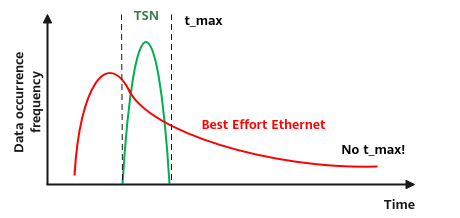
Comparison of data transmission delays (TSN vs traditional Ethernet)
IEEE 802.1Qav, IEEE 802.1Qbv, IEEE 802.1Qbu, IEEE 802.1Qch, and IEEE 802.1Qcr provided by TSN are used for data scheduling and traffic shaping. IEEE 802.1Qbv uses non-preemption data scheduling. The traffic scheduling mode is controlled by timeslots. Data flows that need to be transmitted in real time are transmitted first. In addition, bandwidth is reserved for best-effort data and reserved data, time-sensitive flows and non-time-sensitive flows can be transmitted on the same network, and real-time data transmission is guaranteed.
As shown in the following figure IEEE 802.1Qbv timeslot division, when IEEE 802.1Qbv is used, packets are scheduled for end-to-end transmission in a repetition period. IEEE 802.1Qbv defines three basic types of traffic: time-sensitive flows, best-effort flows, and reserved flows. Time-sensitive flows refer to key messages that have strict requirements on real-time performance. Best-effort flows are common Ethernet flows that do not require any QoS. In addition, reserved flows refer to frames that require a specific bandwidth reservation and have soft real-time requirements.
IEEE 802.1Qbv defines the gates for enabling or disabling frame transmission through the scheduling algorithm. It divides Ethernet communication into periods with fixed-length and continuous repetition. These periods are divided into timeslots. In each timeslot, data is transmitted by being assigned different priorities. Therefore, time-sensitive flows have dedicated timeslots, ensuring their deterministic transmission on the traditional Ethernet. Reserved flows and best-effort flows are accommodated in the remaining timeslots of each period. The reserved flows are guaranteed with dedicated bandwidth, and the best-effort flows can use the remaining bandwidth.
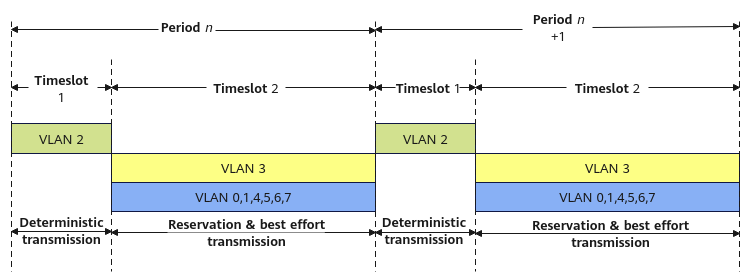
IEEE 802.1Qbv timeslot division
Timeslot 1 in the figure is reserved only for time-sensitive flows. Timeslot 2 is used by the best-effort flows and reserved flows, and dedicated bandwidth is reserved for the reserved flows.
TSN sends different types of flows based on different timeslots, all network devices must be synchronized within nanoseconds.
Reliability
The timeliness and high reliability of data transmission need to be ensured for applications that have high requirements on real-time data transmission. This helps cope with problems caused by bridge node failures, line disconnections, and external attacks, ensuring function security and network security. IEEE 802.1Qci, IEEE 802.1CB, and IEEE 802.1Qca are used to implement TSN performance to address the problems.
IEEE 802.1CB provides the dual-link redundancy feature for the Ethernet. This feature ensures that only one copy of data frames is received by numbering and replicating each data frame in the source system and relay system of the network, and eliminating these replicated frames in the target system and other relay systems. This feature prevents packet loss caused by congestion, reduces the probability of packet loss caused by device faults, and shortens the fault recovery time, improving network reliability.
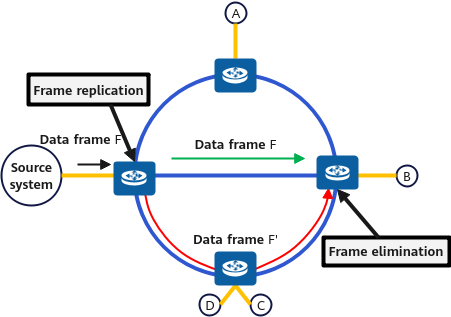
Working principles of IEEE 802.1CB
Resource Management
In TSN, each real-time application has specific requirements on network performance. Enabling a feature on a TSN network involves configuring and managing available network resources. It allows some TSN sub-protocols to be configured on the same network to properly allocate resources on network paths and ensure that the resources can be used as expected. The TSN resource management sub-protocols include the IEEE 802.1Qat and IEEE 802.1Qcc protocols. The IEEE 802.1Qcc protocol is an enhancement of the IEEE 802.1Qat protocol.
IEEE 802.1Qat is the flow reservation protocol. Data admission control is specified based on the requirements on flow resources and available network resources. Resources are reserved and all network nodes between the data sender and the data receiver are notified to ensure that sufficient network resources on the entire transmission path are available for the specified flows.
What Are the Application Scenarios of TSN?
TSN is typically applied to the industrial Internet. Traditional industrial automation is implemented by using hard-coding programmable logic controllers (hard PLCs) and human-machine interfaces (HMIs) on each access network side to control robots and fixtures. Each access network requires a hard PLC to process services in a distributed manner, making management and O&M difficult, as shown in the figure Traditional industrial campus solution. In addition, when a production line changes frequently, massive resources are consumed in adapting a hard PLC to the production line and in performing the commissioning, due to the hard coding of the hard PLC.
If a PLC is directly connected to the factory data center, the software-coding virtual PLC (vPLC) can be used. The figure Traditional industrial campus solution vs. TSN-based industrial campus solution shows the vPLCs on the IT infrastructure platform (FushionCube) of the converged architecture. The production equipment can be managed remotely in a centralized manner. In addition, vPLCs can adapt to the production line through software programming, so the production expansion is flexible. However, the factory data center usually manages IT and OT in a unified manner. Production service flows, office service flows, and other data flows need to be sent to the factory data center through the same network. In addition, industrial automation control requires the millisecond-level deterministic arrival of data flows. Traditional real-time Ethernet cannot implement deterministic communication or transmit time-sensitive and non-time-sensitive data on the same network. Therefore, vPLCs in the factory data center cannot centrally manage production machines (robots and fixtures). This is where TSN comes in. TSN-related protocols are enabled on the vPLCs and gateways connected to production machines to construct a TSN network, as shown in the figure Traditional industrial campus solution vs. TSN-based industrial campus solution. Both time-sensitive data and non-time-sensitive data can be transmitted on the same network at the millisecond or even microsecond level. In this way, vPLCs can perform remote management in a centralized manner, making production more secure, maintenance more convenient, and production line adjustment more flexible.
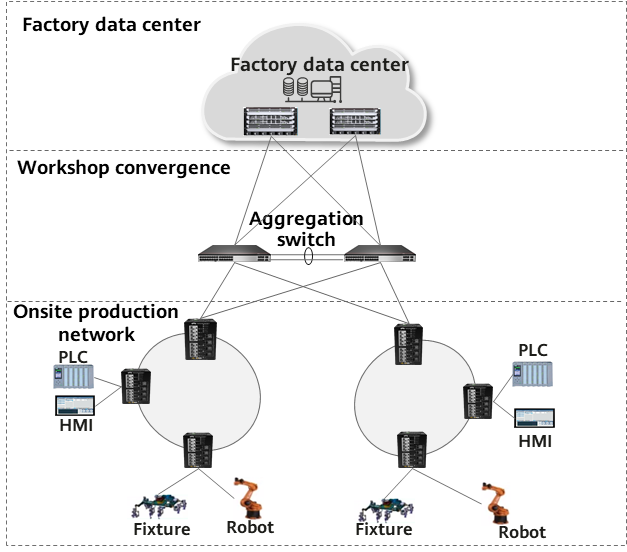
Traditional industrial campus solution

Traditional industrial campus solution vs. TSN-based industrial campus solution
- Author: Fu Xiaoqin
- Updated on: 2024-02-27
- Views: 1802
- Average rating:






